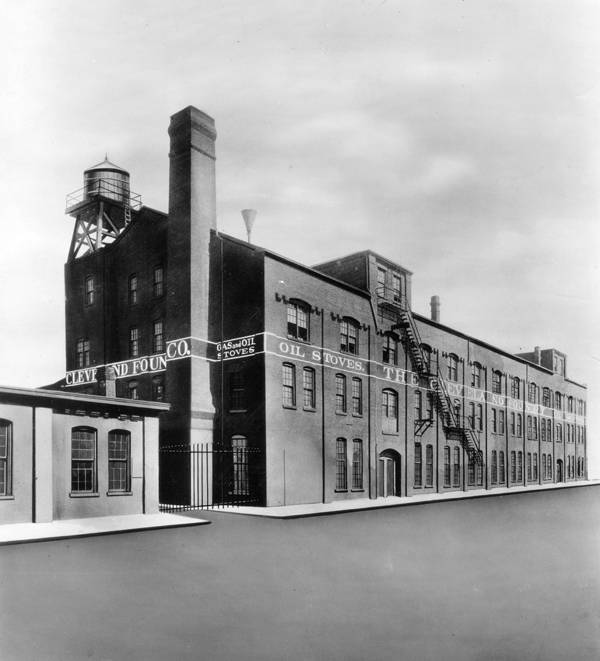
The son of Dewitt and Sarah Dimmick Drury, Francis Edson Drury was born on August 20, 1850, in Pittsfield, Michigan. After receiving a public-school education, he entered the hardware business where he invented the first internal gear lawnmower. Drury moved to Cleveland in 1870 and worked with the Taylor and Boggis Foundry Company to manufacture his mowers. In addition, and some years later, he partnered with H.P. (Henry Parsons) of Chicago to start the Cleveland Foundry Company, which built oil heating and cooking stoves.
Drury served as vice president, president, and general manager of the Taylor and Boggis Company, also known as T&B Foundry Company. On March 31, 1906, a fire destroyed not only the Taylor & Boggis Company but also the H.C. Tack Company, resulting in a $20,000 loss. The Tack Company suffered more damage because it was primarily a wood-frame building, unlike the mostly brick T&B building. Several months after the death of Robert H. Boggis, T&B's president, on June 10, 1911, from complications of pneumonia, the company purchased a large plot of land near East 55th Street and the old Erie tracks where it planned to build a new foundry and power plant. This land was previously owned by the Schofield-Schurmer-Teagle Company, which was (at the time) an oil plant. The buildings would be built of the most up-to-date machinery and in a modern style.
Because of the enormous success he had on his inventions, Drury built one of the last remaining homes on Euclid Avenue at East 87th Street. This mansion, composed of 34 rooms and 25,000 square feet, is located at 8615 Euclid Avenue. Drury, his wife Julia and their son lived at this location for twelve years. In 1924, however, Drury felt it was time to live in a more pastoral setting. As a result, in 1925 the Drurys decided to follow the route many of their neighbors took, relocating to an affluent eastern suburb. They bought the 155-acre Cedar Hill Farm in Gates Mills, Ohio, and built an almost exact duplicate of their home but nearly 1.5 times its size. Today, the mansion, also known as the Tudor House, is on the campus of Gilmour Academy.
The new Drury home, situated near the corner of Cedar and S.O.M. Center Roads, has 41 rooms and 14 fireplaces (each made with marble from a different country), and each of its major rooms (i.e. master bathroom, kitchen, master bedroom) is finished with a different type of wood. When the Drurys lived there, the property also contained seventeen different buildings, including a creamery, vegetable-cleaning building, and toolshed. Almost five acres were greenhouses that grew not only vegetables but flowers as well. The surprising thing to note is that Drury and his wife lived on this property for only a year. Francis E. Drury passed away on April 3, 1932, and his wife, Julia, died 11 years later on April 16, 1943.
After Drury and his wife left their original home on Euclid Avenue, it was closed off to the public until the Drury Club acquired it on June 11, 1939. The Cleveland Plain Dealer described the home as a fine example of 17th-century-style architecture. Up to this point in time, forty carefully chosen men and women spent most of their Saturday nights here enjoying dinner and a bit of dancing with their guests. The Drury Club later entered negotiations to sell the Drury mansion to the Florence Crittenton Home in 1946.
The Florence Crittenton Home officially inaugurated the Drury mansion as its new home in 1948. The mansion served as a maternity home of unmarried mothers and their children. Originally organized as a branch of the National Florence Crittenton Mission, the home was able to care for fifteen unwed mothers during pregnancy and for them and their infants for up to six months after delivery. The home had a part-time nursing staff and visiting physician to provide medical care as well as volunteers from Protestant and other women’s organizations to assist with activities and services.
The organization fought against social stigmas of the time. Many people viewed unwed mothers as ‘sinful’ or ‘undeserving’ because they believed these women's situations reflected a moral failure. Institutions such as the Crittenton Home guaranteed the mothers a sense of safety, mostly on the premise of spiritual reclamation. As public opinion in the latter decades of the twentieth century shifted, places such as the Crittenton Home became obsolete. These changing ideas, in conjunction with the loss of the organization's executive director, ultimately brought about the end of the Florence Crittenton Home in the mansion in 1971. Although the Florence Crittenton Organization continued to have a presence in Cleveland with a newfound focus on helping delinquent girls in a new treatment center, the branch at the Drury mansion had met its end.
The Florence Crittenton Home leased the building to AIM Jobs, and a Community Reintegration Center opened in the building in February 1973. The Center provided programs to treat parole and probation violators. It differentiated itself from traditional half-way houses in that it was designed to diagnose and treat the problems of parole violators. This provided a new opportunity as opposed to automatically sending them back to serve additional jail time.
The mansion continued to be used by the Reintegration Center until its sale in 1989 to the Cleveland Clinic. Renamed the Foundation House, the Clinic’s administration partly restored the mansion's first level to a condition similar to that in which the Drurys had left it in 1924. The work done by the Clinic was recognized in 1995 by the Cleveland Restoration Society. Overall, the mansion has been adaptively reused as a conference center and office space for the Clinic building where it hosts receptions, graduations for medical residents, and some Cleveland Clinic Foundation board meetings today.
Images





